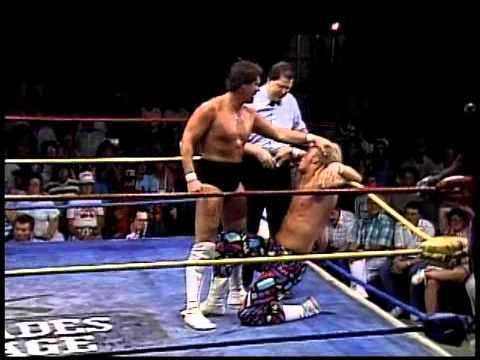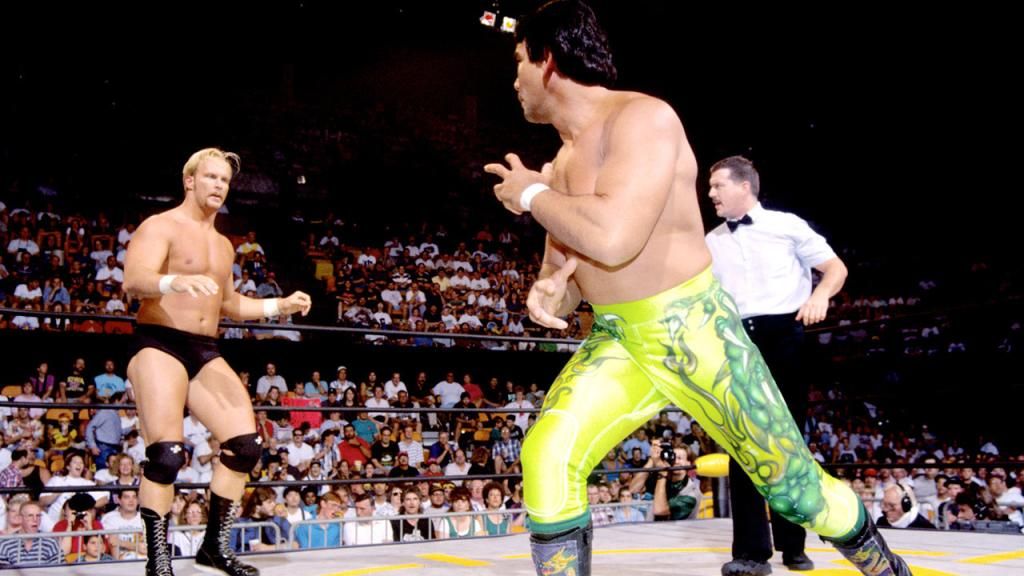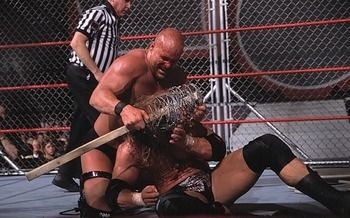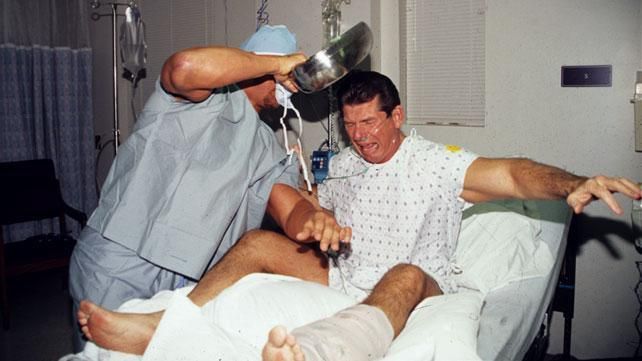wrestling / Columns
The Magnificent Seven: The Top 7 Steve Austin Rivalries
When we talk about the proverbial Mount Rushmore of professional wrestling, there are but a handful of performers who garner legitimate consideration for a spot. Hulk Hogan. Bruno Sammartino. Gorgeous George. Ric Flair. The Rock. Lou Thesz. John Cena.
Steve Austin.
Austin didn’t have an especially long career in wrestling, but few stars have ever burned brighter. He built a career off of some of wrestling’s most electric feuds, and this week I’m taking a look at the seven very best of them.

#7. Chris Adams
Three things I have a soft spot for:
1) a good mentor-pupil blood feud
2) honoring guys’ first major programs
3) WCCW
I grew up in an upstate New York suburb, and thus had the equal parts exhilarating and frustrating experience of trying to keep up with WCCW and USWA programming despite changing time slots, sporadic breaks in airing the show, and my my mother’s insistence that I was watching too much gosh darn wrestling and if I wanted to watch WWF on the weekends, I shouldn’t be watching WCCW on the weekdays after school. (I suppose that last one was a personal issue.)
All that said, one of the few meaningful angles I remember from my fledgling days as a WCCW and USWA fan was the program between rookie Steve Austin, and his trainer, fringe main event talent Chris Adams. In some regards you can dismiss this as Bruno Sammartino-Larry Zbyszko lite, with brash young ingrate trying to get the best of the veteran who trained him. Sure, this angle borrows from earlier stories like that and no, it doesn’t reach the heights of that particularly iconic iteration of the tale, but it is a hotly contested feud between a budding star who is far better than anyone would expect for him to be for how legitimately inexperienced he was (Austin), and a vastly underrated star who never quite got his day in the sun on the truly national stage (Adams). This angle also had the intrigue of Jeannie and Tori Adams adding wrinkles to the rivalry—a dynamic that grew more complicated when Austin became involved in a real-life affair with Jeannie.
When I think about Austin’s success as a professional wrestler, I tend to think of his number one defining attribute to be fire. He’d crank his piss and vinegar up to eleven as Stone Cold years later, but this program demonstrated the first signs of what vicious, active performer Austin could be in the ring and on the mic.

#6. Kurt Angle
Austin and Angle each arrived at the heights of their wrestling careers around the Attitude Era. For Austin, it was the case of a supremely charismatic veteran shifting the direction of an entire era. For Angle, it was a case of a versatile and outrageously talented star proving adaptable to the times and making his persona work outside of what was probably his natural element.
Austin’s career had a relatively slow burn rise, while Angle’s skyrocketed, which meant they coexisted in the main event despite their active, in-ring careers overlapping for fewer than five years. What’s more, they proved near-perfect foils for another. In their first encounters, Austin was playing the character he’s best known for—reckless, bad ass, and hateful, looking to take a swing at anyone who dared cross his path. Angle had quickly transitioned from a doomed All-American good guy gimmick to startlingly good comedic heel who grappled and cheated his way to the top of the card. In the next, and arguably best iteration of their rivalry, the two were on opposite sides of the WWF-Alliance war. In an unlikely shift, Austin played the cowardly heel to Angle’s ass kicking wrestling machine. And though the men were quite arguably better in the reverse face-heel orientations, they each played their parts so well for that program leading up to Summerslam 2001 that fans nearly forgot those alignment issues. By the fall, Angle and Austin were a hilarious frenemy pair, playing a co-leadership role within The Alliance, only for Austin to end up a face again in the aftermath of that angle, at which point he got back to laying a whooping on heel Angle.
Both men would run into health issues in the years that followed. As we all know, Austin retired after WrestleMania 19. Angle carried on with WWE into the summer of 2006 before disagreements with management about his own injuries led to an untimely departure, after which he signed on with TNA. It’s a shame we didn’t more years of the Austin-Angle rivalry. Just the same, what we did get stands out as some of the finest work in each man’s distinguished career.

#5. Ricky Steamboat
Ricky Steamboat is best remembered for his time as an arch-rival and near-perfect in ring opponent for Ric Flair in the NWA in 1989. Austin is best known for his WWF work in the late 1990s. Just the same, Austin and Steamboat collided when they were headed on opposite trajectories up and down the card, respectively, in early 1990s WCW. The two would feud over the TV Championship in the fall of 1992, the tag team titles (Steamboat teamed with Shane Douglas, Austin with Brian Pillman) in spring 1993, and then the US Championship in summer and early fall of 1994.
Steamboat was, in so many ways, a proving ground for Austin as his relentlessly aggressive in-ring style proved an awesome match for Steamboat’s artful selling. The two produced fast-paced matches that effortlessly blended technical wrestling and brawling elements. Better yet, Austin’s smug, mean character was an ideal antagonist for the family man persona Steamboat had espoused by that point in his career.

#4. Triple H
I suspet the debates about Triple H’s career will linger off after he hangs up his boots for good as an in-ring performer. Did achieve the heights of his career success based on ability or marrying into the McMahon family? Is he a brilliant psychologist or a plodding performer who was too dependent on rest holds? Did he hog the spotlight or carry the company as one of its greatest heel champions?
Regardless of your opinion on the questions above, I’d contend that Triple H will go down as one of wrestling’s all-time great strategists. As he’s documented in numerous interviews, he witnessed the meteoric rises of Steve Austin and The Rock and knew that he could either try to compete with them for the status of top face in the company or lobby to turn heel and be their chief antagonist in perpetuity. Lo and behold, the scheme worked. While Rock and Austin have to be considered among each other’s greatest rival, Triple H can’t be considered that far down either man’s list of great on-screen enemies. More over, with Austin, Rock, and Mick Foley, he completed a quartet of stars that were fixtures in the main event scene throughout the peak years of the Attitude Era.
The Austin-Triple H rivalry was long one, in which the two had a handful of encounters in the mid-card, Triple H played Shawn Michaels’s sidekick opposite Austin in the build to WrestleMania 14, and then became enemies by proxy when Triple H left Degeneration X to join Vince McMahon’s Corporation. The two performed in a triple threat match with Foley at SummerSlam 1999, and that program would end up carrying on through the fall, before Austin infamously got run over in the parking garage before he would have faced Trips and The Rock at Survivor Series. Austin would come back a year later and Rikishi would be discovered to be the wheel man, only for Triple H to reveal a short while after that that he was the mastermind behind the attack. In the months to follow, Austin would drop Triple H, in his car, from a forklift, the two would participate in a six-man Hell in a Cell war, and bring their personal rivalry to a head in an epic Three Stages of Hell Match.
In the aftermath of WrestleMania 17, Triple H and Austin aligned themselves as the heel Two-Man Power Trip. All indications were that Triple H would eventually turn face (whether or not the angle involved The Alliance), with a number of reports suggesting that they would go on to blow off their feud once and for all at WrestleMania 18. But in reality, Triple H would go down with a quad injury that took him out for the latter half of 2001. By the time he was back in action, both men were faces. With the possible exception of Austin acting as a thorn in Triple H and other heels’ sides as the co-GM and Sherriff of Raw, and their most recent shoot podcast interview on the WWE Network, the two never had a really meaningful interaction on-air again.
Based on how heated both Austin and Triple H could be in the ring and on the mic, they delivered a very good extended program with each other. Take debilitating injuries out of the equation, and it’s entirely possible their collective stock would have risen even higher, and helped Triple H break the top three of this countdown.

#3. Bret Hart
Steve Austin showed up in the WWF at just the right time, and under just the right set of circumstances, with just the right supporting cast to lead a revolution in professional wrestling—completing the transition from a family friendly product, to a cutting edge and adult-oriented style.
You can argue that shift was inevitable, or that characters like Austin and The Rock might have helped steer the ship in that direction regardless of who helped them make the transition. But as history stands, I’d argue that no one did more to legitimize and put over Austin, and perhaps inadvertently spark the Attitude Era, than Bret Hart.
The Hart-Austin rivalry started when The Hitman returned from a spell away from the WWF, only to find that Steve Austin had risen in his absence—a brash, vicious character who was calling him out. The two engaged in a very good bout at Survivor Series 1996, which Hart barely managed to win, pinning Austin while trapped in a Million Dollar Dream sleeper that Austin refused to let go of.
The rivalry might have ended there, but instead, when Shawn Michaels lost his smile, the WrestleMania 13 card got shuffled, and Hart ended up squaring off with Austin again. The two delivered what many have called the single greatest match in WrestleMania history, including a double turn such that Hart, who had been losing steam with fans, went heel, and Austin who had, against most conventional logic, been getting more popular, emerged as a de facto face for his refusal to submit to the Sharpshooter.
In the months to follow, Hart would make up with his brother Owen, and recruit Brian Pillman and historical allies Jim Neidhart and Davey Boy Smith to form the Hart Foundation, a red hot heel stable that benefited from the added intrigue of being fan favorites north of the Canadian border, and despised in the US. Austin would lead the charge against Hart as the two warred on through all manner of tag team configurations.
Austin and Hart represented opposite philosophies in so many ways—Hart a holdover from a more traditional period in wrestling history and Austin a renegade pushing a new style; Hart a Canadian and Austin a Texas redneck; Hart a guy who let his wrestling do most of his talking for him while Austin would just not stop running his mouth. But most importantly of all, Austin and Hart were two brillian wrestlers who assembled some of the greatest matches of their time.

#2. The Rock
When I started drafting this list, there were only two names that I gave serious consideration for the number one spot. It’s a testament to Austin and the unique brand of chemistry he had with each of these top to performers that it seems preposterous that either of them not end up in the number one spot.
I say all of this to provide context—The Rock ends up at the number two spot in this countdown, but there was absolutely nothing about the Rock-Stone Cold rivalry that was second-rate. Austin and The Rock each attained their peaks during the same period. And while wrestling has had so many great rivalries, I’d go so far as it say that no rivalry has ever had this much star power, for this sustained a period of time. Austin was an approximate equal to Hulk Hogan in terms of mainstream recognition—the true face of wrestling when the general public probably couldn’t have named more than a couple stars. And, perhaps counterintuitively, though Rock was a step behind Austin in the wrestling world, he went on to become the single biggest crossover star in wrestling history when he transitioned to a highly successful career in the movie business.
While the two had a number of other run-ins, it’s easiest to boil down their wrestling rivalry to three matches—a WrestleMania trilogy that I doubt we’ll ever truly see matched. At WrestleMania 15, Rock represented The Corporation and Vince McMahon. He was finding his footing as a main event fixture, and though the match was good, it wasn’t exactly great. WrestleMania 17 saw Austin and The Rock lock horns as equals—after missing a year due to injury, Stone Cold was a step removed from the peak of his popularity while, in Austin’s absence, The Rock had climbed up the ladder to meet him. The pair delivered a bona fide top ten WrestleMania match and the perfect main event to what was arguably WWE’s greatest show of all time. Finally, the two squared off at WrestleMania 19. Austin’s body was deteriorating, and though he didn’t publicize the bout as a retirement match, it was evident he couldn’t remain a top level in-ring performer for too much longer. Meanwhile, Rock had already started the transition to his acting career, and fans were rightfully dubious he’d ever be ours full-time again. Thus, they had their sign off match, with The Rock back to a heel persona. The two played all the hits, demonstrated their maturity as performers, and delivered a worthy finale to one of wrestling’s great rivalries.
Rock-Austin didn’t have the in-ring polish of Bret Hart-Shawn Michaels, the physical mystique of Hulk Hogan-Andre the Giant, or the clash of cultures represented in John Cena-CM Punk. But when we consider this pairing alongside WWE’s other most iconic rivalries, it does offer a combination of star power, in-ring performance, mic work, and longevity that solidifies it as one of the greatest feuds in wrestling history. There was only one better in Austin’s career…

#1. Vince McMahon
The Steve Austin-Vince McMahon feud is the single most important program in wrestling history. It was the backbone of The Attitude Era. It was the genesis of Austin as arguably the biggest star in wrestling history. It defined the role of heel authority figure that, for better or worse, has now been a staple for fifteen years. And it was just so goddamn entertaining.
Were you to consider this program four or five years before it happened, it would seem absurd: a career mid-carder mechanic, warring against the WWF’s owner and lead announcer, who had never been in a match. But turn loose both of these men’s personalities and something magical happened. It turned out Austin had the piss and venigar to reinvent what being a wrestling hero might mean, while McMahon had an unbelievable combination of heel charisma, physique, and willingness to get pummeled and humiliated that created magic. Austin-McMahon created countless captivating moments on Monday Night Raw. The rivalry defined the 1999 Royal Rumble and St. Valentine’s Day Massacre show to follow, and provided key background context for the WrestleMania 14 and 15 main events. From the beer bath, to the bedpan, to their first non-match, to showing up on opposite sides of the WWF-Alliance War, to reprising their old chemistry on the Raw Homecoming special, Austin-McMahon was one of the most truly special products WWE has ever produced, and may be all the more remarkable for having entertained fans so thoroughly, without ever really producing any particularly good matches between the two. For all of these factors, and all of these moments there was no greater Steve Austin rivalry in my mind than the one he had with Vince McMahon.
What were your favorite Steve Austin rivalries? Which did I miss that you felt deserved a spot? Eric Bischoff? Brian Pillman? Undertaker? Kane? Mick Foley? My own list of honorable mentions got pretty unwieldy. Let us know what you think in the comments section. See you in seven.
Read stories and miscellaneous criticism from Mike Chin at his website and his thoughts on a cappella music at The A Cappella Blog. Follow him on Twitter @miketchin.







